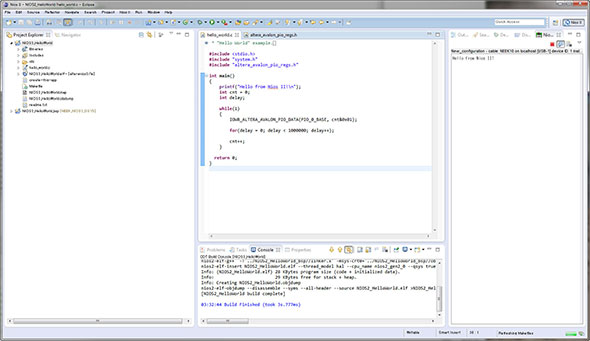「MAX 10 NEEK」へソフトコアCPUを組み込む:MAX 10 FPGAで学ぶFPGA開発入門(9)(5/6 ページ)
» 2016年04月12日 12時00分 公開
[大原 雄介,MONOist]
LチカをソフトコアCPUから操作する
さて、ここまでできたので次はLチカをCPUから操作する方法である。コードをList 2の様に書き換える(Photo27)。まずPIOの操作を行うAPI(というかマクロ)は、altera_avalon_pio_regs.h(これはBSPの方のdrivers/incの下にある)に定義されている。IOWR_ALTERA_AVALON_PIO_DATA()がそれで、指定したアドレスに値を書き込むというものである。
今回だと値はcnt++の値にあわせて0か1なので、点滅が行われるというわけだ。続くforループは単なるdelayである。ちなみに指定したアドレスがPIO_0_BASEとなっているが、これはQSYSで指定した名前を大文字にして、最後に"_BASE"が付加されたものになる。これを実行すると、Movie01の様に右端のLEDが一定間隔で点滅する。
Movie1:MAX10 NEEKのソフトCPUからLEDを操作
List 2:
/*
* "Hello World" example.
*
* This example prints 'Hello from Nios II' to the STDOUT stream. It runs on
* the Nios II 'standard', 'full_featured', 'fast', and 'low_cost' example
* designs. It runs with or without the MicroC/OS-II RTOS and requires a STDOUT
* device in your system's hardware.
* The memory footprint of this hosted application is ~69 kbytes by default
* using the standard reference design.
*
* For a reduced footprint version of this template, and an explanation of how
* to reduce the memory footprint for a given application, see the
* "small_hello_world" template.
*
*/
#include <stdio.h>
#include "system.h"
#include "altera_avalon_pio_regs.h"
int main()
{
printf("Hello from Nios II!\n");
unsigned long cnt = 0;
long delay;
while(1)
{
IOWR_ALTERA_AVALON_PIO_DATA(PIO_0_BASE, cnt&0x01);
for(delay = 0; delay < 1000000; delay++);
cnt++;
}
return 0;
}
endmodule
List2
関連記事
 周辺機器の充実した「MAX 10 NEEK」で本格的な開発を目指す
周辺機器の充実した「MAX 10 NEEK」で本格的な開発を目指す
FPGA開発において周辺機器(回路)は見落とせない要素の1つ。タッチパネルや各種出入力などを備えた「MAX 10 NEEK」を導入して、本格的な開発を目指す。 FPGAのソフトコアCPUをベンチマークで測定する
FPGAのソフトコアCPUをベンチマークで測定する
FPGA「MAX10」に「NIOS II」と呼ばれるソフトIPコアを導入することで、ソフトコアCPUを構築できる。ではその処理能力はどれほどか。ベンチマークソフトで測定してみよう。 FPGA上でソフトコアCPUを動かす手引き
FPGA上でソフトコアCPUを動かす手引き
これまでFPGAの開発基礎としてLチカなどを紹介してきたが、今回はちょっと目先を変えてFPGA上でのCPUコア動作に取り組む。今回も連載で使う「MAX 10 FPGA 評価キット」の読者プレゼントをご用意。 よろしいならばダイナミック点灯だ――FPGAでLEDをダイナミックにLチカさせる
よろしいならばダイナミック点灯だ――FPGAでLEDをダイナミックにLチカさせる
単純なLチカならばFPGAでもそう難しくない。ただ、ダイナミック点灯やそれに伴うソースの最適化については“ならでは”のポイントが散見される。今回も連載で利用している「MAX 10 FPGA 評価キット」の読者プレゼントをご用意。 FPGAのLED制御プログラムを深く理解する
FPGAのLED制御プログラムを深く理解する
FPGA開発に必要なHDLへの理解を深めるため、MAX 10に用意されているArduino I/Oを利用してのLチカを行い、多灯LEDの制御を含めたプログラミングも解説する。今回も連載で使う「MAX 10 FPGA 評価キット」の読者プレゼントをご用意。 FPGAでのLチカをVerilog HDLで理解する
FPGAでのLチカをVerilog HDLで理解する
今回はFPGAでのLチカを例に、FPGA開発に必要なハードウェア記述言語の解説をしたい。用いる「Verilog HDL」はArduinoやCの経験がある方なら、理解そのものはそう難しくないと思う。今回も連載で使う「MAX 10 FPGA 評価キット」の読者プレゼントをご用意。 「MAX 10 FPGA」のテスト環境を構築する
「MAX 10 FPGA」のテスト環境を構築する
今回から実際に「MAX 10 FPGA評価キット」を利用しての開発に着手する。まずは環境構築だ。キット以外に必要なモノもあるので注意して欲しい。今回も連載で使う「MAX 10 FPGA 評価キット」の読者プレゼントをご用意。 なぜFPGAが注目されるのか、開発ボードに触れて確認する
なぜFPGAが注目されるのか、開発ボードに触れて確認する
最近では「FPGAの重要性」について語られる機会が増え、適用事例も増加している。ではなぜ今FPGAなのか。実際の開発ボードでFPGAを学びながら、FPGAへの理解を深めよう。連載で使う「MAX 10 FPGA 評価キット」の読者プレゼントもご用意。
Copyright © ITmedia, Inc. All Rights Reserved.
組み込み開発の記事ランキング
- 5G通信の遅延時間1ms以下は複数端末の制御でも可能か、東芝が量子技術で道を開く
- CAN通信におけるデータ送信の仕組みとは?
- イチから全部作ってみよう(7)正しい要求仕様書の第一歩となるヒアリングの手順
- CANプロトコルを理解するための基礎知識
- 組み込みシステム向けRTOSのシェアはTRON系が約60%
- インフィニオンのSiC-MOSFETは第2世代へ、質も量も圧倒
- 【問題7】10進数を2進数に変換するプログラム
- 景気減速でソフト開発の脆弱性対応が後手に? SBOM整備の取り組みも足踏みか
- テスト消化曲線とバグ発生曲線の7パターン診断
- 6Gに向けたサブテラヘルツ帯対応無線デバイス、100Gbpsの超高速伝送を実証



